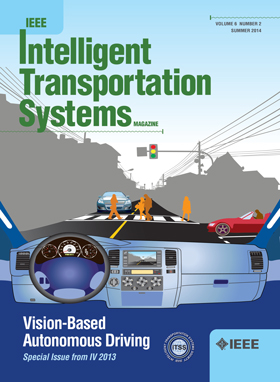面向路面裂缝检测的多粒度上下文信息流建模
IF 8.4
1区 工程技术
Q1 ENGINEERING, CIVIL
IEEE Transactions on Intelligent Transportation Systems
Pub Date : 2025-06-12
DOI:10.1109/TITS.2024.3438883
引用次数: 0
摘要
路面裂缝具有高度复杂的空间结构,背景对比度低,空间连续性弱,这给有效的裂缝检测方法带来了很大的挑战。为了从图像中精确定位裂缝,关键是要有效地提取和聚合多粒度上下文,包括裂缝周围的细粒度局部上下文(在空间层面)和粗粒度语义(在语义层面)。本文采用扩展卷积作为主干特征提取器对局部上下文进行建模,然后构建上下文引导模块,利用语义上下文指导多阶段的局部特征提取。为了处理阶段之间的标签对齐,我们应用多实例学习(MIL)策略来对齐两个阶段之间的特征。此外,据我们所知,我们已经发布了最大、最复杂、最具挑战性的沥青路面裂缝(BPC)数据集。在三个裂纹数据集上的实验结果表明,该方法性能良好,优于目前最先进的方法。在BPC上,该模型在45.36 GFlops的运行速度下,以16.89 M的参数实现了88.32%的AP。数据集和代码可在:https://github.com/pangjunbiao/BPC-Crack-Dataset上公开获取。本文章由计算机程序翻译,如有差异,请以英文原文为准。
Modeling Multi-Granularity Context Information Flow for Pavement Crack Detection
Pavement cracks have a highly complex spatial structure, a low contrasting background and a weak spatial continuity, posing a significant challenge to an effective crack detection method. To precisely localize crack from an image, it is critical to effectively extract and aggregate multi-granularity context, including the fine-grained local context around the cracks (in spatial-level) and the coarse-grained semantics (in semantic-level). In this paper, we apply the dilated convolution as the backbone feature extractor to model local context, then we build a context guidance module to leverage semantic context to guide local feature extraction at multiple stages. To handle label alignment between stages, we apply the Multiple Instance Learning (MIL) strategy to align the feature between two stages. In addition, to our best knowledge, we have released the largest, most complex and most challenging Bitumen Pavement Crack (BPC) dataset. The experimental results on the three crack datasets demonstrate that the proposed method performs well and outperforms the current state-of-the-art methods. On BPC, the proposed model achieved AP 88.32% with the 16.89 M parameters under the 45.36 GFlops runing speed. Datset and code are publicly available at: https://github.com/pangjunbiao/BPC-Crack-Dataset .
求助全文
通过发布文献求助,成功后即可免费获取论文全文。
去求助
来源期刊

IEEE Transactions on Intelligent Transportation Systems
工程技术-工程:电子与电气
CiteScore
14.80
自引率
12.90%
发文量
1872
审稿时长
7.5 months
期刊介绍:
The theoretical, experimental and operational aspects of electrical and electronics engineering and information technologies as applied to Intelligent Transportation Systems (ITS). Intelligent Transportation Systems are defined as those systems utilizing synergistic technologies and systems engineering concepts to develop and improve transportation systems of all kinds. The scope of this interdisciplinary activity includes the promotion, consolidation and coordination of ITS technical activities among IEEE entities, and providing a focus for cooperative activities, both internally and externally.
 求助内容:
求助内容: 应助结果提醒方式:
应助结果提醒方式:


